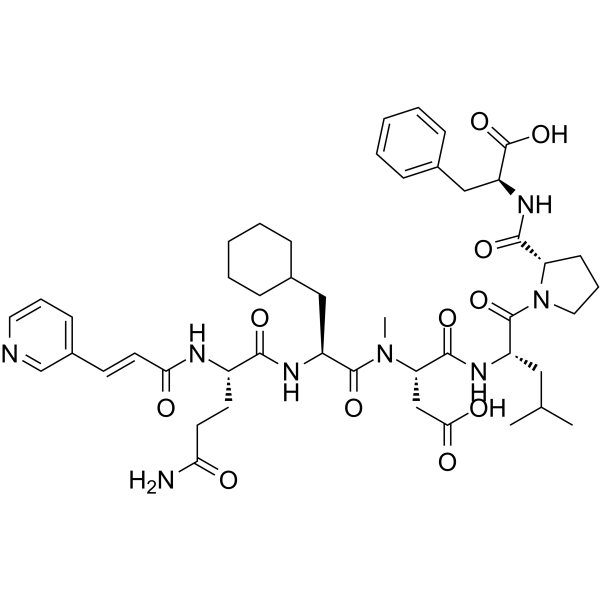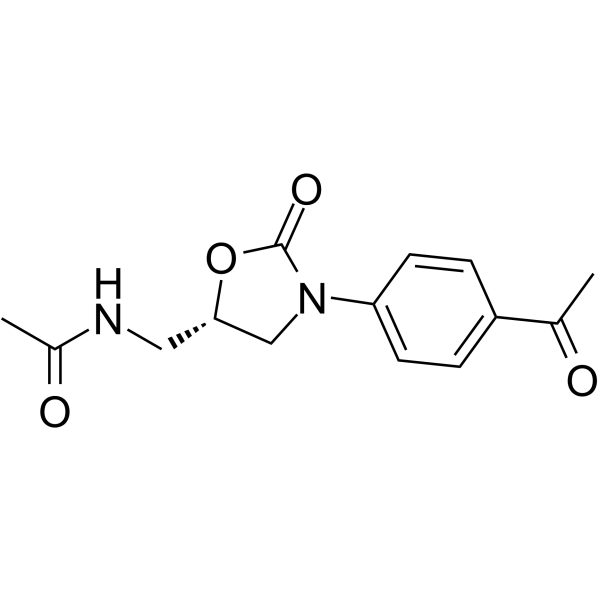 To enhance service speed and avoid tariff delays, we've opened a US warehouse. All US orders ship directly from our US facility.
To enhance service speed and avoid tariff delays, we've opened a US warehouse. All US orders ship directly from our US facility.
| Cat. No. | Product Name | Field of Application | Chemical Structure |
|---|---|---|---|
| DC75950 | apo-Enterobactin |
apo-Enterobactin is a derivative of Enterobactin.
More description
|

|
| DC75949 | Antibacterial synergist 3 |
Antibacterial synergist 3 is a dual-acting inhibitor of biofilm (IC50 of PAO1: 0.40 μM and IC50 of PA14: 1.45 μM). Antibacterial synergist 3 reduces virulence production by inhibiting the quorum sensing (QS) system and induces iron deficiency in P. aeruginosa PAO1. Antibacterial synergist 3 enhances the efficacy of Tobramycin and Ciprofloxacin in a mouse wound infection model. Antibacterial synergist 3 can be used for the research of P. aeruginosa infections.
More description
|

|
| DC75948 | Angolamycin |
Angolamycin is a basic macrolide antibiotic active against Gram-positive bacteria.
More description
|

|
| DC75947 | Amidinomycin |
Amidinomycin is mainly resistant to Gram-positive bacteria (weak).
More description
|

|
| DC75946 | Albonoursin |
Albonoursin, a microbial secondary metabolite, is an antibacterial peptide. Albonoursin displays antibacterial and antitumor activities.
More description
|

|
| DC75945 | Alahopcin |
Alahopcin is a dipeptide antibiotic with a broad antibacterial spectrum.
More description
|

|
| DC75944 | AK-968-11563024 |
AK-968-11563024 is an inhibitor of marine V. vulnificus NAT [ (VIBVN)NAT] with an IC50 of 18.86 µM. NATs (Arylamine N-acetyltransferases) in marine V. vulnificus plays a role in drug metabolism, contributing to the development of drug resistance. Therefore, AK-968-11563024 can be utilized in research related to drug resistance.
More description
|

|
| DC75943 | 9-tert-Butyldoxycycline |
9-tert-Butyldoxycycline exhibits immunomodulatory activity, alters the polarization states polymorphonuclear neutrophils, and ameliorates the inflammatory response in ischemia-reperfusion injury model. 9-tert-Butyldoxycycline is the ligand for ‘Tet-On’ switch system.
More description
|

|
| DC75942 | 8-Nonynoic acid |
8-Nonynoic acid (non-8-ynoic acid) is a fatty acid that belongs to the group of octynoic acids. It exhibits antibacterial activity against gram-positive bacteria by binding to bacterial fatty acids. 8-Nonynoicacid also inhibits growth of gram-negative bacteria by inhibiting the synthesis of fatty acids. It is also capable of inhibiting growth of both aerobic and anaerobic bacteria in biochemical assays.
More description
|

|
| DC75941 | 8-Hydroxyerythromycin A |
8-Hydroxyerythromycin is a semi-synthetic antibiotic with an antibacterial activity.
More description
|

|
| DC75940 | 2,2',4'-Trichloroacetophenone |
2,2',4'-Trichloroacetophenone (Compound 3) is an α-haloacetophenone analogue. 2,2',4'-Trichloroacetophenone exhibits good antibacterial activities against Xanthomonas oryzae pv. oryzae (Xoo) and Xanthomonas axonopodis pv. citri (Xac) with EC50 values of 0.54 and 2.02 mg/L, respectively. 2,2',4'-Trichloroacetophenone can be used for antibacteria study.
More description
|

|
| DC75939 | 1-Aminoacridine |
1-Aminoacridine (1-Acridinamine) is a bright fluorescent dye. 1-Aminoacridine acts as an anti-infective agent and mutagen due to its ability to interact with DNA.
More description
|

|
| DC75938 | 11-Hydroxynovobiocin |
11-Hydroxynovobiocin has anti-Gram-negative bacteria effect.
More description
|

|
| DC75937 | 10-Deoxymethymycin |
10-Deoxymethymycin (Antibiotic YC 17) displays antibiotic activity against Gram positive bacteria.
More description
|

|
| DC75936 | (R)-DS86760016 |
(R)-DS86760016 is the R-enantiomer of DS86760016 and a linker. Mc-Pro-PAB-MMAE can be used for synthesis of ADCs.
More description
|

|
| DC75935 | (E/Z)-MC4 |
(E/Z)-MC4 is an enantiomer of the antibacterial agent MC4, which has antibacterial activity against a group of Staphylococcus aureus strains including MRSA, and has no significant toxicity to mammalian cells.
More description
|

|
| DC75934 | (-)-Luteoskyrin |
(-)-Luteoskyrin has a wide range of antibacterial activity, such as against malaria (with an IC50 of 0.51 μg/mL), tuberculosis (MIC of 6.25 μg/mL), and it also shows antibacterial effects (with MIC for Gram-positive bacteria ranging from 0.39 to 1.56 μg/mL, and for Gram-negative bacteria from 3.13 to 12.50 μg/mL), as well as antifungal activity (with MIC against plant pathogens ranging from 3.13 to 50μg/mL). (-)-Luteoskyrin exhibits cytotoxicity against NCI-H187 cells, with an IC50 range of 0.16–17.99 μg/mL.
More description
|

|
| DC47736 | Targeting the bacterial sliding clamp peptide 46 Featured |
Targeting the bacterial sliding clamp peptide 46 is a short peptide targeting the bacterial sliding clamp(SC), inhibiting SC-dependent DNA synthesis.
More description
|

|
| DC70585 | MBX3132 Featured |
MBX3132 is a small mocule inhibitor of AcrB multidrug efflux pump, fully potentiates the activity of a broad range of antibiotics at 0.1 uM; does not exhibit membrane-disrupting or antibacterial activity.
More description
|

|
| DC72921 | COE2-2hexyl Featured |
COE2-2hexyl represents an innovative class of antimicrobial agents, demonstrating broad-spectrum antibacterial activity through its unique conjugated oligoelectrolyte (COE) structure.
More description
|

|
| DC70591 | mCLB073 Featured |
mCLB073 is an advanced, orally active small molecule agonist specifically designed to target Mtb adenylyl cyclase Rv1625c. As an optimized derivative of V-59, it demonstrates significantly enhanced potency and efficacy for in vivo applications. In cholesterol-based media, mCLB073 shows a remarkable 17-fold increase in activity against Mtb compared to its predecessor, V-59, while retaining favorable pharmacokinetic characteristics and a strong safety profile. In preclinical studies, oral administration of mCLB073 at 30 mg/kg led to a substantial reduction in Mtb colony-forming units (CFUs) in the lungs of mice, accompanied by a 45% decrease in lung pathology severity. These findings highlight its potential as a promising therapeutic candidate for tuberculosis treatment.
More description
|
.gif)
|
| DC72952 | Savirin Featured |
Savirin (S. aureus virulence inhibitor) is a small molecule that targets the agr (accessory gene regulator) quorum sensing system in Staphylococcus aureus (S. aureus). The agr system is a key regulatory pathway that controls the expression of virulence factors in S. aureus, which are critical for its pathogenicity. The system involves a two-component signal transduction pathway consisting of AgrC (a histidine kinase) and AgrA (a response regulator).
More description
|

|
| DC70908 | Xeruborbactam |
Xeruborbactam (QPX7728) is an ultrabroad-spectrum beta-lactamase inhibitor with remarkable activity against a wide range of beta-lactamases, including those that are typically resistant to other inhibitors.
More description
|

|
| DC41156 | Cilastatin sodium Featured |
Cilastatin sodium (MK0791 sodium) is a reversible, competitive renal dehydropeptidase I inhibitor with an IC50 of 0.1 μM. Cilastatin sodium inhibits the bacterial metallob-lactamase enzyme CphA with an IC50 of 178 μM. Cilastatin sodium is an antibacterial adjunct.
More description
|

|
| DC8115 | Vancomycin hydrochloride Featured |
Vancomycin hydrochloride in stock,price: 500 USD/100mg. 0
More description
|

|
| DC1057 | Fidaxomicin (Dificid) Featured |
Fidaxomicin, is an antibiotic that belongs to the class of macrocylic antibiotics.
More description
|

|
| DC47231 | Dup-721 Featured |
DuP-721 is a broad spectrum and orally active antibacterial agent against a variety of clinically susceptible and resistant bacteria, especially M. tuberculosis.
More description
|

|
| DC42084 | Phenazine methylsulfate Featured |
Phenazine methylsulfate is a free radical generator. Phenazine methylsulfate has been used as an electron transfer reactant in cell viability assays. Phenazine methylsulfate induces ssDNA break formation in the presence of the reducing agent NADPH. Phenazine methylsulfate induces oxidative DNA damage in an alkaline comet assay and apoptosis.
More description
|

|
| DC4226 | Moxifloxacin hydrochloride Featured |
Moxifloxacin(Avelox, Avalox) is a fourth generation synthetic fluoroquinolone antibacterial agent.
More description
|

|
| DC28080 | Ro 20-0657/000 Featured |
Ro 20-0657/000 is a metabolite of Trimethoprim. Trimethoprim is a dihydrofolate reductase inhibitor, used as an antibacterial agent in human and veterinary medicine.
More description
|

|